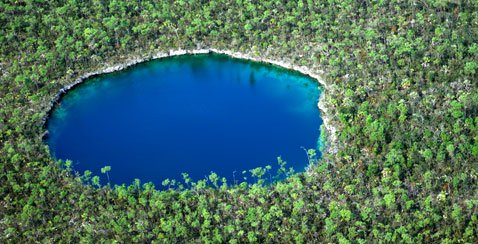BLUE HOLE
A blue hole is a large marine sinkhole, which is open to the surface and has developed in a bank or island composed of a carbonate bedrock (limestone or coral reef). Blue holes typically contain tidally-influenced water of fresh, marine, or mixed chemistry. They extend below sea level for most of their depth and may provide access to submerged cave passages. Well-known examples can be found in South China Sea (Dragon Hole), Belize, the Bahamas, Guam, Australia (in the Great Barrier Reef), and Egypt (in the Red Sea).
Blue holes are distinguished from cenotes in that the latter are inland voids usually containing fresh groundwater rather than seawater.

Description
Blue holes are roughly circular, steep-walled depressions, and so named for the dramatic contrast between the dark blue, deep waters of their depths and the lighter blue of the shallows around them. Their water circulation is poor, and they are commonly anoxic below a certain depth; this environment is unfavorable for most sea life, but nonetheless can support large numbers of bacteria. The deep blue color is caused by the high transparency of water and bright white carbonate sand. Blue light is the most enduring part of the spectrum; other parts of the spectrum—red, yellow, and finally green—are absorbed during their path through water, but blue light manages to reach the white sand and return upon reflection.
The deepest blue hole in the world at 300.89 meters (987 feet) deep is in the South China Sea and is named the Dragon Hole, or Longdong.[2] The second deepest blue hole in the world with underwater entrance at 202 metres (663 ft) is Dean's Blue Hole, located in a bay west of Clarence Town on Long Island, Bahamas. Other blue holes are about half that depth at around 100–120 metres (330–390 ft). The diameter of the top entrance ranges typically from 25–35 metres (82–115 ft) (Dean's Blue Hole) to 300 metres (980 ft) (Great Blue Hole in Belize).
Formation
Blue holes formed during past ice ages, when sea level was as low as 100–120 metres (330–390 ft) lower than at present. At those times, these formations were targets of the same erosion from rain and chemical weathering common in all limestone-rich terrains; this ended once they were submerged at the end of the ice age.
Most blue holes contain freshwater and saltwater. The halocline is the point in these blue holes where the freshwater meets the saltwater and where a corrosive reaction takes place that eats away at the rock. Over time this can create side passages, or horizontal "arms", that extend from the vertical cave. These side passages can be quite long; e.g., over 600 metres (2,000 ft) in the case of the Sawmill Sink in the Bahamas.
ARTICLE SOURCE

✅ @mdsahar, I gave you an upvote on your first post! Please give me a follow and I will give you a follow in return!
Please also take a moment to read this post regarding bad behavior on Steemit.
Downvoting a post can decrease pending rewards and make it less visible. Common reasons:
Submit
Hi! I am a robot. I just upvoted you! I found similar content that readers might be interested in:
https://morgoblogocon.wordpress.com/2015/04/23/the-blue-hole-of-santa-rosa-new-mexico/
Downvoting a post can decrease pending rewards and make it less visible. Common reasons:
Submit
Congratulations @mdsahar! You received a personal award!
You can view your badges on your Steem Board and compare to others on the Steem Ranking
Vote for @Steemitboard as a witness to get one more award and increased upvotes!
Downvoting a post can decrease pending rewards and make it less visible. Common reasons:
Submit